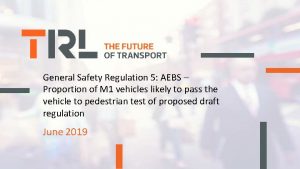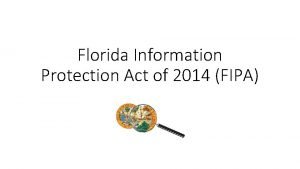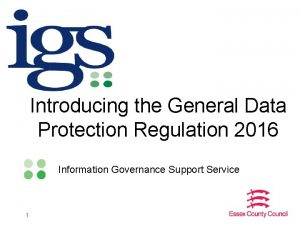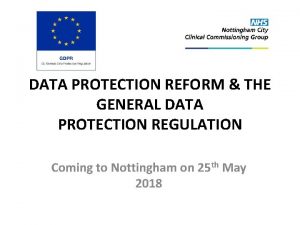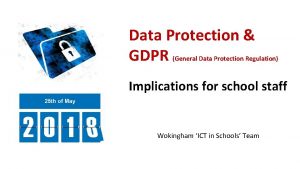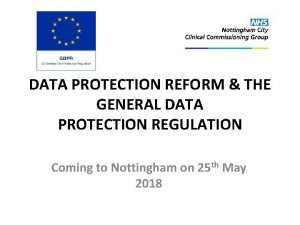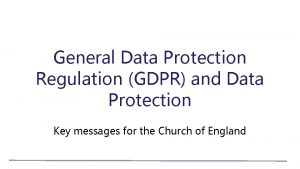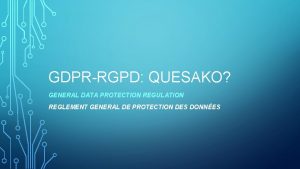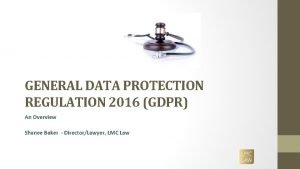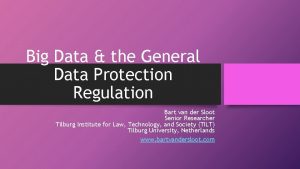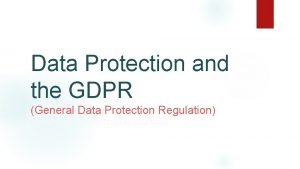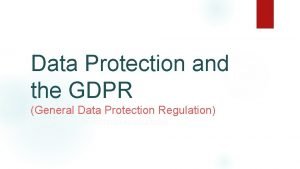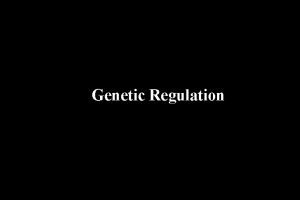Introducing the General Data Protection Regulation 2016 Information
























- Slides: 24

Introducing the General Data Protection Regulation 2016 Information Governance Support Service 1

Focus for today’s session • New legislation – key areas of change • Preparation tasks • Information Asset Register • Records of Processing Activities • Privacy Notices • Consent • Data Protection Officers • Where to access help 2

What, why and when? • • • 3 Replacement for the Data Protection Act 1998 Fit for purpose in our digital world The GDPR comes into force on 25 th May 2018 We must comply with Data Protection Act 1998 (DPA) until then

Information Commissioner’s Speech 24 th May 2017 4

Key areas of change The new legislation brings in requirements such as: • • 5 Codes of Conduct & Certification Schemes Privacy Impact Assessments Prescribed Security measures Notification of data breach/loss Outsourcing requirements Changes to the Legal basis’ for using personal data Biometrics added to sensitive data items Statutory Data Protection Officer post

Key preparation tasks • Understand what personal data you have (pupils/staff/parent/carers) and how you are using it • Understand what the law requires you to do with personal information to carry out your service • Check your website privacy notice to ensure it accurately reflects what you are doing with personal data, and use the ICO guidance to ensure you have captured all of the requirements – ico. org. uk 6

Key preparation tasks – contd. • Where you are using consent, consider if you really do need it, or does one of your statutory duties require you to do it? • Ensure any consent forms point to your online privacy notice • Familiarise yourselves with the Whole Essex Information Sharing Framework portal – weisf. essex. gov. uk which provides guidance and templates on key processes • Ensure you have a robust policy and procedure for managing data breaches 7

Weisf. essex. gov. uk 8

Where to start? (Records Management) You have to know what you already have in terms of personal data, and what you are doing with it, before you can start implementing GDPR elements. This is best achieved by: Create or review your Information Asset Register, ensuring its completeness and accuracy Guidance - http: //www. nationalarchives. gov. uk/documents/informationmanagement/identify-information-assets. pdf Template - https: //weisf. essex. gov. uk/Documents/iar_template. xls 9

Where to start? (Securing data) Map ALL of your Data Flows (in/out/static) Pull this data together with your information asset register, either creating a relational database, or in smaller settings, a spreadsheet Guidance https: //weisf. essex. gov. uk/Documents/Information%20 Mapping%20 Guidance% 20 Document%2007%2001%2008. doc Template https: //weisf. essex. gov. uk/Documents/Copy%20 of%20 Data%20 flow%20 mappi ng%20 template%202013 -14. xls 10

Where to start? (Evidencing compliance) Add in the remaining elements required under Article 30 to produce your full Records of Processing Activity, these include: – – – Details of the Data Controller and DPO Purpose of processing Categories of Data, Recipients and subjects Link to associated PIA/privacy notice/contract/ISP Transfers overseas, which country and the safeguards applied A description of the technical and organisational security applied to personal data – A list of Data Processors, with names and contact details, any associated representatives, and their DPO contact details *Template available for IGS when purchasing support 11

Key Legislative Changes – Privacy Notice For GDPR compliance add: • • Data Protection Act requirements for Privacy Notices • • • The legal basis for the processing Contact details of the Data Protection Officer Automated decision-making, including profiling The right to withdraw consent at any time Is provision of personal data a statutory or contractual requirement? The right to data portability where applicable Transfers of personal data overseas https: //ico. org. uk/for-organisations/guide-to-dataprotection/privacy-notices-transparency-andcontrol/where-should-you-deliver-privacy-information-toindividuals/ 12

Best Approach to Privacy Notices Once you have compiled your Records of Processing Activity, you will have full sight of all of the processing you carry out, and must then make sure that your privacy notice covers every element of processing: • Main privacy notice should be hosted on your website – Sub menus at the side to break down types of processing will help users access the correct details for their data, e. g. : • Pupils • Parents • Staff • 3 rd Parties/Contractors • All consent forms and data capture forms must point to the webpage privacy notice, and explain how to access if no internet connectivity • See example at www. essex. gov. uk/privacy 13

Best Approach to Privacy Notices- Contd. • Use all communications channels available to you to publicise your privacy notice • You MUST explain how you process personal data across your organisation via your privacy notice, regardless of whether you have a statutory duty for the processing, or are using consent • Ensure you capture your processing of staff data, including any volunteers Accessibility Ensure your privacy notices are: • Clear, plain English • Clear to a child where a notices is directed at them • Has an easy read version • Has a link to Google Translate • Link your privacy notices to your Records of Processing Activity 14

Consent Ensure you understand your statutory duties. Re-familiarise yourselves with your relevant legislation e. g. Education Act, Education & Skills Act, Children Act etc. , so you are clear about how, and to what extent, the law requires you to process personal data. It is possible that you are currently seeking consent where you do not need to, as you have a statutory duty, causing unnecessary work. Carry out a review to identify these areas, and amend your processes to take account of it, linking through to your Records of Processing Activity. 15

Consent (1) Child Consent from a child only applies to Information Society Services – this means any online services under contract to a child Therefore it is highly unlikely that a school would need to seek child consent, but awareness is key, as case law develops in this area and its scope potentially widens If you do need to gain consent from a child, ensure the request for consent is explained in terms understandable by a child 16

Consent (2) Where consent is necessary, ensure that any consent you collect is: • Clear, unambiguous, explicit, accessible and intelligible • Recorded to evidence that consent was given • Provided with clear instruction on how to withdraw that consent • Without an imbalance of power 17

Data Subject Rights under GDPR The GDPR strengthens the rights of individuals in how their personal data is used. For example there are new rights relating to: • Restricting processing • Right to be forgotten • Rights in relation to profiling • Data Portability And amended/strengthened rights in relation to: • Right to rectification • Right to erasure • Access rights 18

Data Protection Officer The Data Protection Officer (DPO) is a new statutory post prescribed in the regulation. Each School must assign a DPO, either internally, outsourced, or in an umbrella group, e. g. MATs where one DPO can be assigned to cover all schools within the Trust. DPOs are not personally responsible in cases of non-compliance with the GDPR. The GDPR makes it clear that it is the controller or the processor who is required to ensure and demonstrate that the processing is in accordance with its provisions. Data protection compliance is a responsibility of the controller or the processor. 19

Data Protection Officer (2) Professional qualities • Expertise in national and European data protection laws and practices, and an in-depth understanding of the GDPR. There should be adequate and regular training for DPOs. • Knowledge of the business sector and of the organisation of the controller is useful. • Understanding of the processing operations carried out, as well as the information systems, and data security and data protection needs of the controller. • In the case of a public authority or body, the DPO should also have a sound knowledge of the administrative rules and procedures of the organisation, including statutory duties. 20

Duties of the DPO The DPO has a duty to monitor compliance with the GDPR, by: • Collect information to identify processing activities • Analyse and check the compliance • Inform, advise and make recommendations to the controller or processor. The controller should seek the advice of the DPO, on the following issues, amongst others : • When to carry out a DPIA • Whether to carry out the DPIA in-house or whether to outsource it • What safeguards to apply to mitigate any risks to privacy rights • Whether or not the DPIA has been correctly carried out and its conclusions are in compliance with the GDPR 21

Legislation for Schools Df. E statutory guidance can be found at: https: //www. gov. uk/government/collections/statutory-guidance-schools • • • • 22 Education & Adoption Act 2016 Education Act 2011 Education & Skills Act 2008 Education & Inspections Act 2006 Education Act 2005 Education Act 2002 Education (Schools) Act 1997 Education Act 1996 Nursery Education and Grant-Maintained Schools Act 1996 Education Act 1994 Education (Schools) Act 1992 Diocesan Boards of Education Measure 1991 Education Reform Act 1988

Help & assistance • ICO. org. uk – DP Reform • WEISF. essex. gov. uk • ECC Education Team • Information Governance Support Service 23

IGS • ECC’s Information Governance Support service (IGS) has a range of services we can provide to support your implementation of the GDPR – Training, • Bespoke focussed sessions • DPO training – Audits – including provision of action plan and templates – Helpdesk for compliance related queries – Statutory requests service We recommend that schools cluster wherever possible to share costs – however audits are bespoke to the school. To access services, please contact us at: • IGS@ESSEX. GOV. UK 24
 General safety regulation
General safety regulation General safety regulation
General safety regulation Sfbb allergen chart
Sfbb allergen chart General knowledge quiz 2016
General knowledge quiz 2016 Five level of prevention
Five level of prevention Insurance specialty group
Insurance specialty group General industry subpart for fire protection
General industry subpart for fire protection 29 cfr 1910 subpart i
29 cfr 1910 subpart i Asset protection for general contractors
Asset protection for general contractors The information security function can be placed within the
The information security function can be placed within the The protection of information in computer systems
The protection of information in computer systems Florida information protection act of 2014
Florida information protection act of 2014 Whats a power verb
Whats a power verb Introduction to english linguistics exercises answers
Introduction to english linguistics exercises answers Introducing james joyce
Introducing james joyce Quotation starters
Quotation starters How to introduce a counterclaim in an argumentative essay
How to introduce a counterclaim in an argumentative essay Introducing yourself for a job
Introducing yourself for a job Warm up introducing yourself
Warm up introducing yourself Ma
Ma Ode poetry definition
Ode poetry definition Digestion
Digestion Kfc gegründet
Kfc gegründet Introducing integers
Introducing integers Mpls internet access
Mpls internet access

